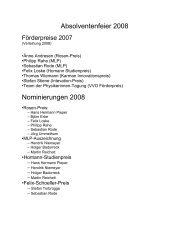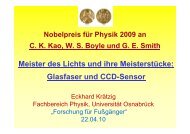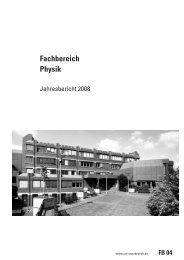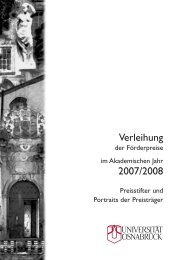Universität Osnabrück, Graduiertenkolleg Mikrostruktur oxidischer
Universität Osnabrück, Graduiertenkolleg Mikrostruktur oxidischer
Universität Osnabrück, Graduiertenkolleg Mikrostruktur oxidischer
Erfolgreiche ePaper selbst erstellen
Machen Sie aus Ihren PDF Publikationen ein blätterbares Flipbook mit unserer einzigartigen Google optimierten e-Paper Software.
GRADUIERTENKOLLEG MIKROSTRUKTUR OXIDISCHER KRISTALLE 71<br />
Fig. 1. The amplitude (squares) and<br />
frequency ω0 (circles) of oscillations vs the<br />
creation rate ζ of reactants A. The dashed<br />
line divides the oscillatory region (upper<br />
part) from the non-oscillation region (lower<br />
part).<br />
Fig. 2. The amplitude at the system’s<br />
self-oscillation frequency ω0 vs ratio<br />
ωmod/ω0. Parameter ζ=0.08 and modulation<br />
amplitude ∆ζ=0.01.<br />
(ii) To clearly detect the influence of modulation on the oscillatory behavior, let us choose freely the<br />
adsorbtion rate in the non-oscillatory region, e.g., ζ=0.08. Then we fix the modulation amplitude ∆ζ=0.01 and<br />
try various modulation frequencies ωmod. It is detected, that the amplitude of oscillations increases if the<br />
frequency ratio ωmod/ω0 is around one of ½, 1, see Fig. 2. We have observed that in these frequency regions<br />
along with an increase of oscillation amplitude the self-oscillation frequency ω0 locks to the corresponding<br />
modulation frequency ωmod (see Fig. 5. in Ref. [18]). These facts indicate that the increase of oscillation<br />
amplitude can be interpreted as a resonance behavior in the Lotka-type model.<br />
The Lotka-type model is a remarkable simplification of theoretical models available for describing oscillatory<br />
systems. It differs strongly from the real catalytic reactions (e.g., CO catalytic transformation on Pt surface) in<br />
the following respects: (a) concentration oscillations are not connected with surface reconstructions; (b)<br />
diffusion of reactants (a fast and very important process in the real systems) in this case is not taken into<br />
account; (c) the model has an original mechanism of oscillation synchronization (obviously different from that in<br />
real systems), which ensures macroscopical oscillations of reactant concentrations. These oscillations exist<br />
independently on the lattice size without implicating any additional mechanisms of synchronization, like<br />
diffusion.<br />
Nevertheless the detected resonance behavior is similar to the experimentally obtained results for the forced CO<br />
catalysis on a Pt surface [3]. Between the resonance frequencies, our simulations show a quasiperiodic behavior,<br />
similarly to the real experiment. However, in contrast to this experiment, Monte-Carlo computer simulations do<br />
not show resonance behavior for some frequency ratios, e.g., 1:4, 3:5 or 2:3. An increase of the modulation<br />
amplitude in the resonance regions does not lead to a quasiperiodic behavior, like it is observed in the<br />
experiments for frequency ratios 3:5 or 2:3. The transition to chaos has not been detected. One should note that<br />
these discrepancies could arise by two reasons: (a) the Lotka-type model suggests a quite simplificated treatment<br />
of real autocatalytic reactions. Refining the model will lead to better agreement with the experimental data, and<br />
more effects will be reproduced. But this step inavoidably increases the number of parameters in the model and<br />
thus an origin of the resonance behavior will be harder to trace. (b) The specific feature of the Monte-Carlo<br />
method is a large noise level, thus complicating a detection of resonance phenomena. Most probably due to this<br />
particular fact we were not able to detect the resonance behavior at other ratios (e.g., 1:4, 3:5 or 2:3).<br />
A comparison of experimental data with our simulation results allows to draw the conclusion that the resonance<br />
phenomena (like frequency locking and resonance behavior) are not connected to a specific surface reaction,<br />
e.g., CO catalytic oxidation, but they reflect very general aspects of oscillatory processes.<br />
(iii) Now let us consider the limiting case of mobile reactants. Usually diffusion can give rise to segregation of<br />
reactants [10] and other spatio-temporal structures, like running waves or spirals [1]. We have observed the<br />
segregation of reactants, but not the running waves or spirals. This fact is due to a peculiarity of the Lotka-type<br />
model. Namely, an infinite reaction rate A+B→2B determines, that configurations with reactants A and B in the<br />
NN sites do not exist. In other words, the front of reaction goes with an infinite speed and all clusters of A’s are<br />
transformed into clusters of B’s instantly, without any reaction front.<br />
We have observed that diffusion results only in desynchronization of concentration oscillations. The amplitude<br />
of oscillations decreases with an increase of diffusion, see Fig. 3. Particularly, diffusion of reactants A is less







